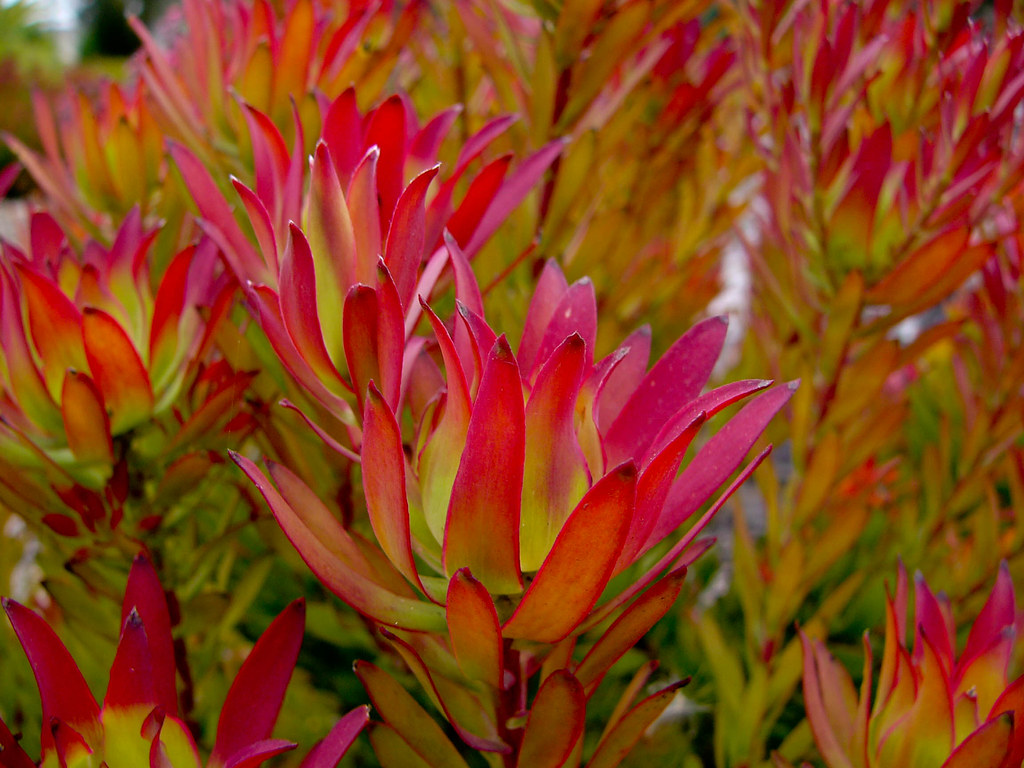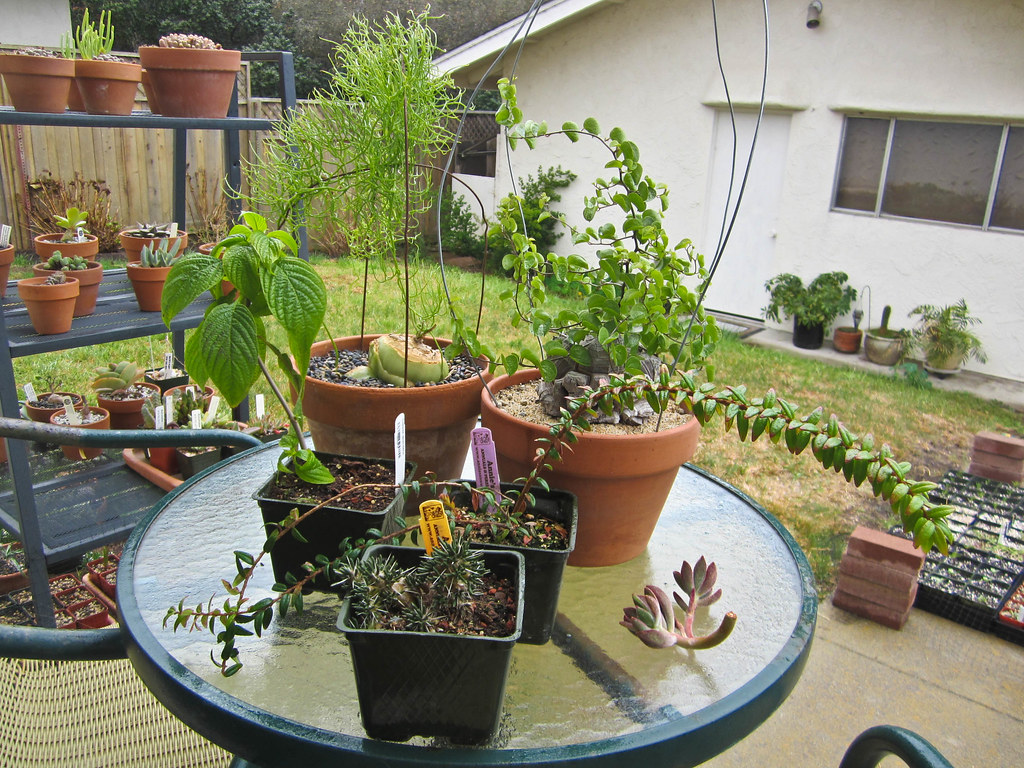Back in November I stopped by to take some pictures of my favorite garden that I designed in Morro Bay. It was installed in January of 2012 by Gardens by Gabriel so is almost 2 years old. I’m really impressed by how big everything has grown in such a short time.
 If you have been following my blog since then you may remember how it looked when it was first installed. This is a screen grab from Google Earth back when the garden was just a month old. You can see the homes proximity to the bay and the ocean (both visible to the left) and Morro Rock is peaking out behind the chimney. The plants were so tiny. The mulch was so bright. I always worry that clients won’t have the imagination to picture what my intentions for the design were.
If you have been following my blog since then you may remember how it looked when it was first installed. This is a screen grab from Google Earth back when the garden was just a month old. You can see the homes proximity to the bay and the ocean (both visible to the left) and Morro Rock is peaking out behind the chimney. The plants were so tiny. The mulch was so bright. I always worry that clients won’t have the imagination to picture what my intentions for the design were.
It just takes a bit of patience.
 Some of the shrubs still have some more growing to do and we did have a few problems with some of the plants but overall my vision for the garden is being realized and each time I visit it looks better and better.
Some of the shrubs still have some more growing to do and we did have a few problems with some of the plants but overall my vision for the garden is being realized and each time I visit it looks better and better.
 I am actually less happy with the area to the left of the bocce court (in the foreground). Perhaps we will go back and make some changes there in the future.
I am actually less happy with the area to the left of the bocce court (in the foreground). Perhaps we will go back and make some changes there in the future.
 But the upper garden looks great. This Agave gypsophila is gorgeous as are the Agave desmettiana ‘Variegata’ and Agave celsii ‘Nova’ in the background. Agave gypsophila is one of the more tender Agave species. It is not especially happy when temperatures dip below 32 degrees. I have one in a container that had finally started to look better after a cold snap last year disfigured it. Now with this recent dip below freezing it is looking a bit rough again. Luckily Morro Bay is usually a few degrees warmer than Los Osos so this garden should be fine.
But the upper garden looks great. This Agave gypsophila is gorgeous as are the Agave desmettiana ‘Variegata’ and Agave celsii ‘Nova’ in the background. Agave gypsophila is one of the more tender Agave species. It is not especially happy when temperatures dip below 32 degrees. I have one in a container that had finally started to look better after a cold snap last year disfigured it. Now with this recent dip below freezing it is looking a bit rough again. Luckily Morro Bay is usually a few degrees warmer than Los Osos so this garden should be fine.
 Agave celsii ‘Nova’ was a later addition. I believe that a design is never finished. In this case once other plants started to grow in I felt like this spot needed something extra. I wanted to use Agave ovatifolia but that wasn’t available. Garden design also requires quick thinking and coming up with appropriate substitutions when needed.
Agave celsii ‘Nova’ was a later addition. I believe that a design is never finished. In this case once other plants started to grow in I felt like this spot needed something extra. I wanted to use Agave ovatifolia but that wasn’t available. Garden design also requires quick thinking and coming up with appropriate substitutions when needed.
 Agave macroacantha ‘Pablo’s Choice’ is pretty sexy with its black (painful) spines and beautiful leaf markings. This usually forms a little colony but so far the gardens owner has been rooting out the pups and keeping the plant solitary.
Agave macroacantha ‘Pablo’s Choice’ is pretty sexy with its black (painful) spines and beautiful leaf markings. This usually forms a little colony but so far the gardens owner has been rooting out the pups and keeping the plant solitary.
 The stems on Euphorbia caput-medusae will eventually elongate and sort of flop around on the soil like snakes. Right now it looks like Medusa has had a crew cut.
The stems on Euphorbia caput-medusae will eventually elongate and sort of flop around on the soil like snakes. Right now it looks like Medusa has had a crew cut.
 Right now Kalanchoe beharensis reminds me a bit of a piece of modern art. Felt blocks that have been haphazardly stacked in a pile.
Right now Kalanchoe beharensis reminds me a bit of a piece of modern art. Felt blocks that have been haphazardly stacked in a pile.
 Do you see the sneaky little Oxalis growing underneath Agave geminiflora? One issue with growing succulents is that removing weeds can be a painful and difficult experience. Sometimes best to just let the plant smother them out.
Do you see the sneaky little Oxalis growing underneath Agave geminiflora? One issue with growing succulents is that removing weeds can be a painful and difficult experience. Sometimes best to just let the plant smother them out.
 I think I have mentioned before that this was sold to us as Echeveria X imbricata but I am a little unsure if that is correct. It is bigger and the leaves are thicker than the E. X imbricata I am used to and the leaves really color up more than I have ever seen before. Perhaps it is just environmental but it is pretty common for plants to be mislabeled.
I think I have mentioned before that this was sold to us as Echeveria X imbricata but I am a little unsure if that is correct. It is bigger and the leaves are thicker than the E. X imbricata I am used to and the leaves really color up more than I have ever seen before. Perhaps it is just environmental but it is pretty common for plants to be mislabeled.
 I love how Furcraea foetida ‘Mediopicta’ matches the yellow plastic guards the phone company put on the metal telephone poll support lines. They added those after the fact. Not the greatest thing to have in your garden but at least the color sort of blends in.
I love how Furcraea foetida ‘Mediopicta’ matches the yellow plastic guards the phone company put on the metal telephone poll support lines. They added those after the fact. Not the greatest thing to have in your garden but at least the color sort of blends in.
 One mistake I will admit to is I used two pairs of plant cultivars that are so similar I have a hard time telling the difference. This is possibly Leucadendron salignum ‘Blush’.
One mistake I will admit to is I used two pairs of plant cultivars that are so similar I have a hard time telling the difference. This is possibly Leucadendron salignum ‘Blush’.
 And this is Leucadendron salignum ‘Winter Red’. Or maybe I have that backward? Looking them up with Google Images or on Flickr doesn’t help as they are just as mixed up there and Leucadendrons are so changeable from month to month.
And this is Leucadendron salignum ‘Winter Red’. Or maybe I have that backward? Looking them up with Google Images or on Flickr doesn’t help as they are just as mixed up there and Leucadendrons are so changeable from month to month.
 This is Grevillea lanigera ‘Coastal Gem’. I think.
This is Grevillea lanigera ‘Coastal Gem’. I think.
 And this is Grevillea lanigera ‘Mt. Tamborintha’. Or maybe strike that and reverse it.
And this is Grevillea lanigera ‘Mt. Tamborintha’. Or maybe strike that and reverse it.
Now when I design a garden I try not to include species or cultivars that are very similar. If only it was so easy as looking at the design plans and seeing which plant was supposed to go where. Unfortunately plants from wholesalers almost never have labels. So it is entirely possible that we even mixed up where each group were supposed to be planted. This can really be a problem if one plant is very different in size or form when it matures but luckily in this case all of these plants are quite similar in their adult size and structure.
Actually hold on a second. I think the Leucadendron salignum ‘Blush’ I posted earlier is actually ‘Winter Red’ and the above picture is the true ‘Blush’. Aaargh! See how confusing this is?
 Fortunately Leucadendron ‘Jester’ is very distinct. No mistaking its tri-color variegation for any other Leucadendron in this garden.
Fortunately Leucadendron ‘Jester’ is very distinct. No mistaking its tri-color variegation for any other Leucadendron in this garden.
 We had some problems with some of the Grevillea ‘Austraflora Fanfare’ we planted in this garden but the one above has performed perfectly. Unfortunately even with our ideal growing conditions most Proteaceae can be persnickety.
We had some problems with some of the Grevillea ‘Austraflora Fanfare’ we planted in this garden but the one above has performed perfectly. Unfortunately even with our ideal growing conditions most Proteaceae can be persnickety.
This Grevillea rhyolitica has performed really well here but the one in my garden planted at the same time is long dead.
 Grevillea ‘Robyn Gordon’ has grown massive in just two years. Already at least 6 feet across.
Grevillea ‘Robyn Gordon’ has grown massive in just two years. Already at least 6 feet across.
 And Arbutus ‘Marina’ is another fast grower. Already towering above me. This is quite a messy plant so be careful not to plant it near walkways or over cars. Fortunately the two in this garden are off to the side where they shouldn’t cause any problems.
And Arbutus ‘Marina’ is another fast grower. Already towering above me. This is quite a messy plant so be careful not to plant it near walkways or over cars. Fortunately the two in this garden are off to the side where they shouldn’t cause any problems.


























































